
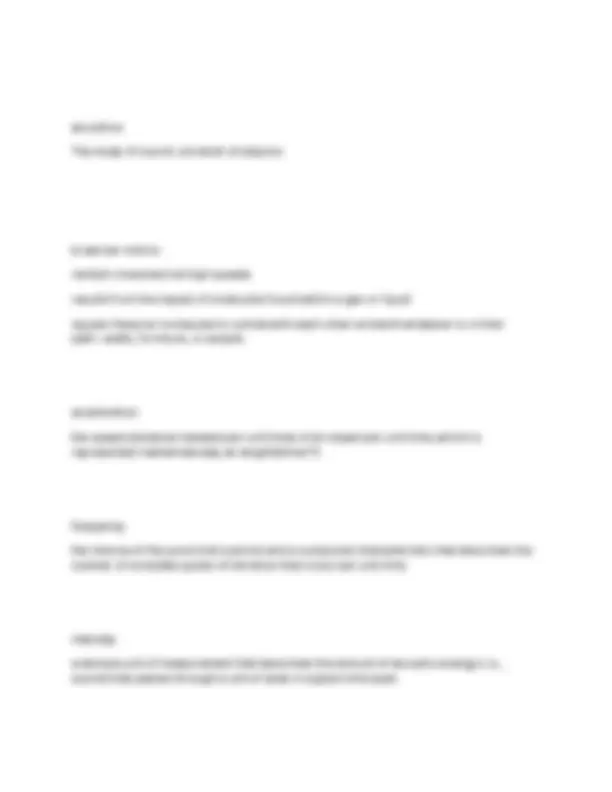
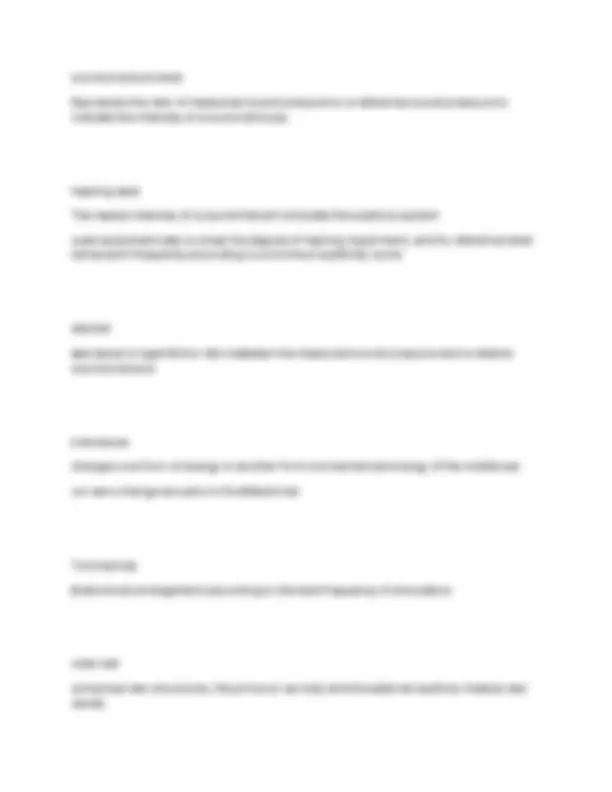
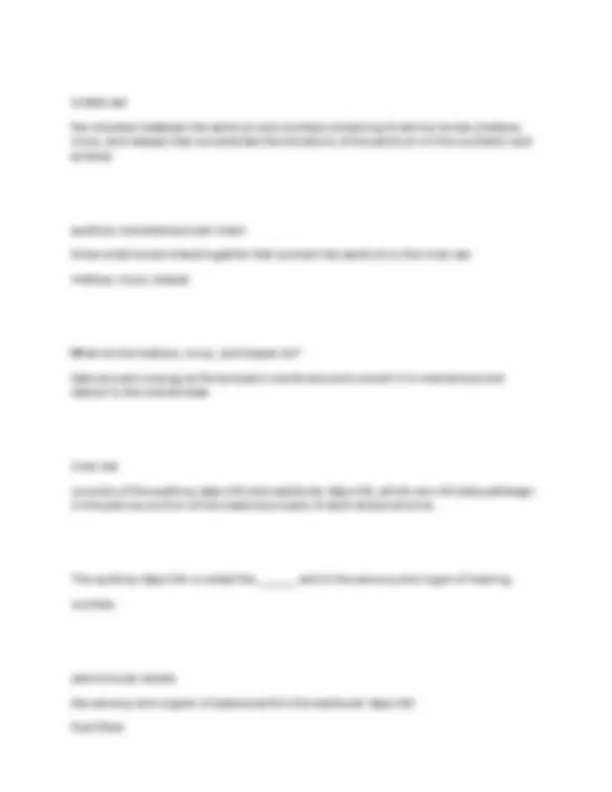
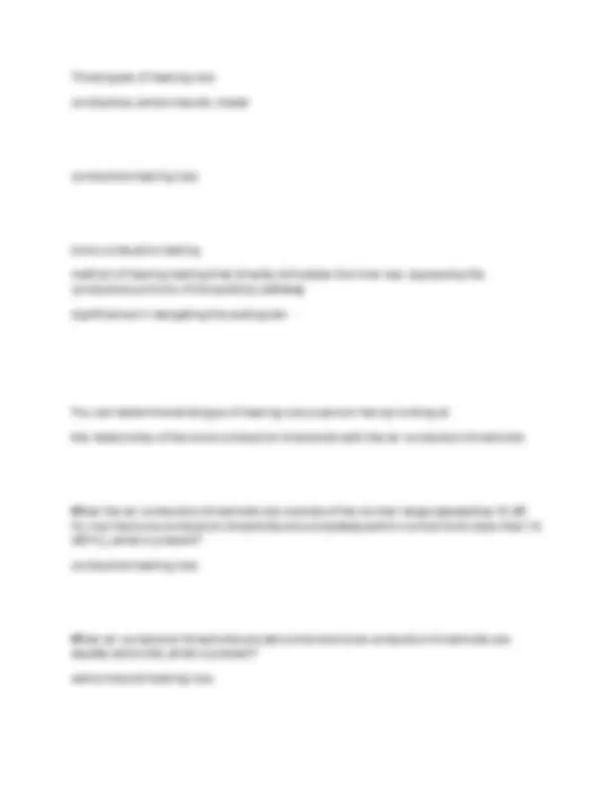
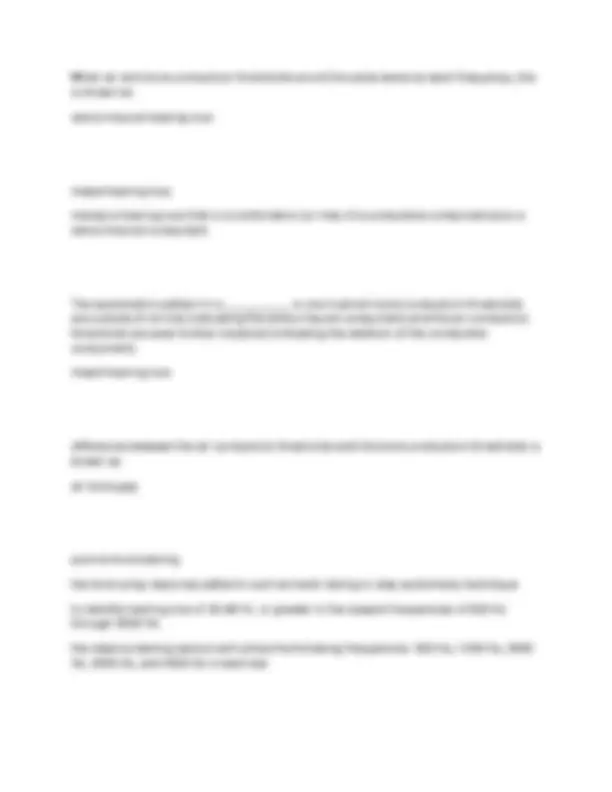
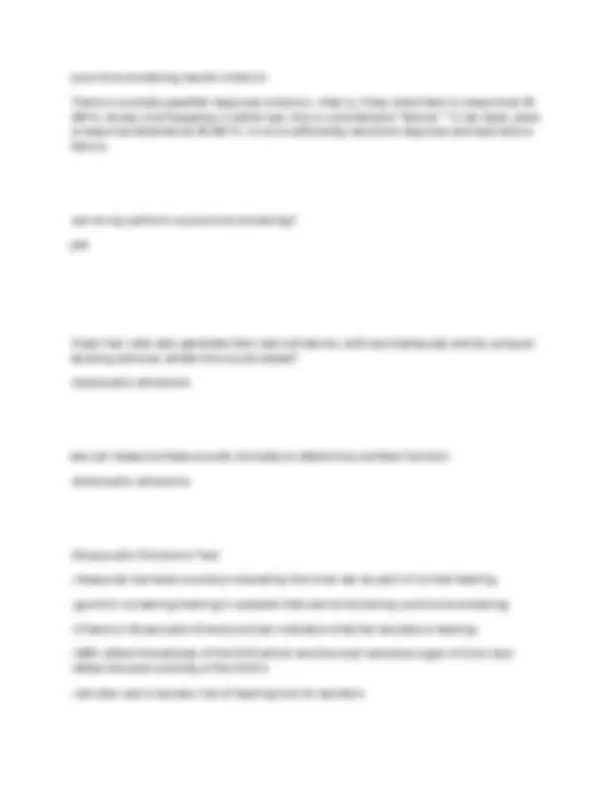


Study with the several resources on Docsity

Earn points by helping other students or get them with a premium plan


Prepare for your exams
Study with the several resources on Docsity

Earn points to download
Earn points by helping other students or get them with a premium plan
Community
Ask the community for help and clear up your study doubts
Discover the best universities in your country according to Docsity users
Free resources
Download our free guides on studying techniques, anxiety management strategies, and thesis advice from Docsity tutors
SLP 5003 EXAM 1 QUESTIONS AND CORRECT ANSWERS!!
Typology: Exams
1 / 12

This page cannot be seen from the preview
Don't miss anything!







Aural habilitation to the delivery of services to newborns, infants, and children born with hearing loss.
aural rehabilitation to the delivery of services to those individuals with acquired hearing loss.
auditory processing ability of the brain to understand speech and spoken language
best practices A clinical process or testing technique that is judged to be scientifically sound and that consistently yields results of better quality than those achieved with other procedures. everchanging, never static not mandated legislative regulations, but rather guidelines used as effective measures for a standard of practice.
evidence based practice as the conscientious, explicit, and judicious use of current best evidence in making decisions about the care of the individual patient.
Universal Precautions a set of procedures and practices designed to help protect healthcare workers and patients alike from a wide range of pathogens.
deaf (lowercase) individuals whose hearing loss is so severe that they cannot use their sense of audition as a primary means of daily communication. These individuals will frequently use some type of amplification, whether hearing aids or cochlear implants, to enhance their hearing to its maximum ability.
Deaf (uppercase) adults and children who share the use of American Sign Language and Deaf culture
Manual communication and speechreading are the primary means of communication for these individuals. Many prefer not to use amplification of any type or to only use amplification on a limited basis depending on circumstance.
hard of hearing a person presenting with a hearing loss who can derive benefit from hearing aids and uses aural/oral speech for communication
hearing impaired felt to draw attention away from the person as an individual and focus directly on the disability itself.
sound a physical phenomenon that is described as the movement or propagation of a disturbance (i.e., a vibration) through an elastic medium (e.g., air molecules) without permanent displacement of the particles.
sound pressure level Expresses the ratio of measured sound pressure to a reference sound pressure to indicate the intensity of a sound stimulus.
hearing level The lowest intensity of a sound that will stimulate the auditory system used audiometrically to show the degree of hearing impairment, and its reference level varies with frequency according to a minimum audibility curve
decibel expresses a logarithmic ratio between the measured sound pressure and a relative sound pressure
transducer changes one form of energy to another form via mechanical energy of the middle ear. our ears change acoustic to fluid/electrical
Tonotopicity Anatomical arrangement according to the best frequency of stimulation
outer ear comprises two structures, the pinna (or auricle) and the external auditory meatus (ear canal).
middle ear the chamber between the eardrum and cochlea containing three tiny bones (malleus, incus, and stapes) that concentrate the vibrations of the eardrum on the cochlea's oval window
auditory ossicles/ossicular chain three small bones linked together that connect the eardrum to the inner ear malleus, incus, stapes
What do the malleus, incus, and stapes do? take acoustic energy at the tympanic membrane and convert it to mechanical and deliver to the oval window
inner ear consists of the auditory labyrinth and vestibular labyrinth, which are intricate pathways in the petrous portion of the mastoid process of each temporal bone.
The auditory labyrinth is called the _______ and is the sensory end organ of hearing; cochlea
semicircular canals the sensory end organs of balance within the vestibular labyrinth fluid filled
If the Eustachian tube is not functioning well, ________ can build up in the normally air-filled middle ear space, which compromises the ______________ ________
fluids; ossicular chain movement
organs of hearing and balance cochlea, semicircular canals
outer hair cells mechanoreceptor cells are shaped like hair about 15,000, form three rows shaped like a W and have their nerve fibers embedded into the tectorial membrane
inner hair cells far fewer in number (about 3,500 altogether), and form a row stretching from base to apex in proximity of the tectorial membrane, near the modiolus (bony core) of the cochlea. more than 90% of these hair cells are neurologically connected to the brain via nerve fibers — they preferentially encode sound clarity.
The ______________ _____________ is where the cochlea begins its analysis of both frequency and intensity of incoming sound signals basilar membrane
Three types of hearing loss conductive, sensorineural, mixed
conductive hearing loss
bone conduction testing method of hearing testing that directly stimulates the inner ear, bypassing the conductive portions of the auditory pathway significance in navigating the audiogram.
You can determine what type of hearing loss a person has by looking at the relationship of the bone conduction thresholds with the air conduction thresholds.
When the air conduction thresholds are outside of the normal range (exceeding 15 dB HL) but the bone conduction thresholds are completely within normal limits (less than 15 dB HL), what is present? conductive hearing loss
When air conduction thresholds are abnormal and bone conduction thresholds are equally abnormal, what is present? sensorineural hearing loss
pure tone screening results criterion There is a simple pass/fail response criterion — that is, if any client fails to respond at 20 dB HL at any one frequency in either ear, this is considered a "failure." To be clear, even a response obtained at 25 dB HL is not a sufficiently sensitive response and warrants a failure.
can an slp perform a pure tone screening? yes
Outer hair cells also generate their own vibrations, both spontaneously and by using an evoking stimulus; whats this sound called? otoacoustic emissions
we can measure these sounds clinically to determine cochlear function. otoacoustic emissions
Otoacoustic Emissions Test -measures low level sounds produced by the inner ear as part of normal hearing -good for screening hearing in subjects that cannot be test by pure tone screening -if there is Otoacoustic Emissions then indication that the neonate is hearing -OAE reflect the activity of the OHC which are the most sensitive organ of Corti and reflect the elctromotility of the OHC's -can also use to access risk of hearing loss for workers
interprofessional collaboration conveys the idea of sharing and implies collective action oriented toward a common goal, in a spirit of harmony and trust, particularly in the context of health professionals
The lack of interprofessional collaboration can result in ... impaired speech-language development, academic progress, social interactions, vocational choices, and more. hearing loss may go undiagnosed
Goal of interprofessional collaboration striving always to improve the quality of patient care.
The watch word for obtaining a case history thorough
Common method to obtain case history obtain or create a form that either a patient can be asked to fill out on his or her own or the clinician can fill out interview style.
An example of a commercially available case history form the Speech-Language-Hearing Case History Form created by and available through Super Duper Publications -geared toward children